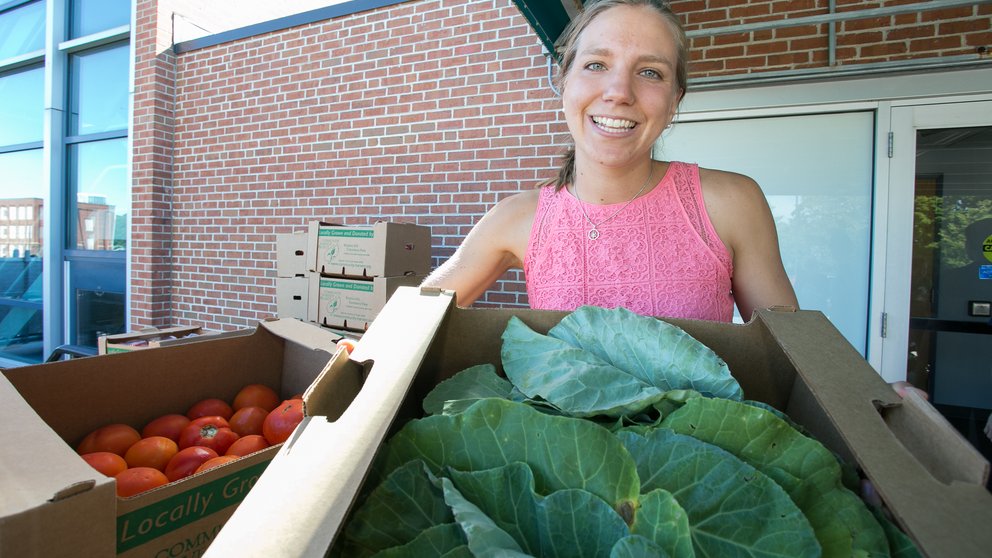
Editor’s Note: Throughout 2015, an AAMCNews series explored how medical schools and teaching hospitals are addressing social determinants of health in their communities through research, clinical care, and education.
World renowned as a center of cooking excellence and innovation, San Francisco is a destination for epicures. But even with its status as a culinary capital, as many as one in four of the city’s residents struggles to find enough to eat, according to the Food Security Task Force of the San Francisco Board of Supervisors.
With help from some medical students, Rita Nguyen, MD, an assistant clinical professor of medicine at the University of California, San Francisco (UCSF), School of Medicine, is addressing that problem on the ground by leading efforts to create the San Francisco General Hospital Therapeutic Food Pantry, which will open in 2016. Adding another dimension to the healthy food focus of the hospital’s Community Wellness Program, patients soon will be able to fill “prescriptions” for healthy food at the pantry as part of their clinical care. An on-site nutritionist will educate visitors about food and its preparation. While it is too soon to determine how many prescriptions UCSF staff will write for food, Nguyen estimates there will be slightly more than 26,000 client encounters in the program’s first year.
“If we can give prescriptions for pills to tackle chronic disease, why can’t we write prescriptions for healthy food?”
Rita Nguyen, MD, University of California, San Francisco, School of Medicine
“We tell our patients they have diabetes or hypertension and should eat better, knowing that a lot of [them] can’t really access that recommendation” because of food insecurity, said Nguyen, who is a faculty hospitalist at San Francisco General. “I’ve been thinking about what we can do better as a health system to address this issue. If we can give prescriptions for pills to tackle chronic disease, why can’t we write prescriptions for healthy food?”
Documenting food insecurity
The U.S. Department of Agriculture (USDA) describes food insecurity as the disruption of food intake or eating patterns because of a lack of money and other resources. The USDA found that in 2013, 14.3 percent of U.S. households were food insecure. That percentage is substantially higher in households where incomes are near or below the federal poverty level and in homes with black and Hispanic families.
Nguyen pointed to a growing body of literature that documents the connection between food insecurity and disease. For example, Hilary K. Seligman, MD, an associate professor at UCSF, along with two colleagues, published a paper in the Journal of Nutrition that found food insecurity was associated with increased risk of hypertension, hyperlipidemia, and diabetes, even after controlling for income. Seligman also collaborated on a paper in the New England Journal of Medicine that concluded, “Our ability to confront today’s problem of food insecurity in a thoughtful, health-promoting, and systematic fashion will have ramifications for health inequities for decades to come.”
Working with Nguyen as a medical student at UCSF last year, Jacob Benjamin Mirsky, MD, conducted focus groups with patients at San Francisco General to pinpoint their challenges around food insecurity. That work was funded by a University of California Global Food Initiative Student Fellowship. Now an intern at Brigham and Women’s Hospital in Boston, Mirsky said studying issues of food access dovetailed with his long-standing personal interest in “developing a more sustainable society and planet.”
Rolling up their sleeves
Given the growing evidence of food insecurity, efforts to address the problem have sprung up at medical schools. Many are led by students. Through an outreach program called Food Rx, students at the University of Arizona College of Medicine work at a community food bank farmer’s market to provide recipes and cooking demonstrations focused on local produce. Kieran Hynes, a student at the school who helps direct Food Rx, frames the program’s goals as “helping people in the community become more aware of the health benefits of food” while trying to show them “how to live as healthy a lifestyle as possible.”
With two fellow students at the University of Massachusetts Medical School, Kathryn Bailey cofounded the Farm-to-Health Center Initiative, which links a community health center and a local farm project that donates food to those in need. In addition to distributing free produce to food-insecure patients, the initiative educates medical staff about food insecurity and promotes food insecurity screening at the health center.
“Right now, medical students are kind of the bridge between the farm and the health center,” Bailey said. “Our goal is to establish a more formal partnership to help this continue and to establish a sustainable funding source.”
In another collaboration, Jeremy Goss, a medical student at Saint Louis University School of Medicine, and two colleagues developed the St. Louis MetroMarket, a nonprofit mobile farmer’s market that takes healthy foods into St. Louis “food deserts.” The group recently acquired a retired city bus that they intend to convert into a roving food dispensary.
Several years ago, Patricia A. Carney, PhD, a professor of family medicine at Oregon Health & Science University School of Medicine, helped direct a program that assisted farm workers to mitigate their food insecurity by growing home gardens. Through the project, the frequency of adults eating vegetables “several times a day” jumped from 18.2 percent to 84.8 percent, and the frequency of participants worrying that food would run out before they found money to buy more dropped from 31.2 percent to 3.1 percent.
Seeing the extent of food insecurity was eye-opening for medical students, Carney said. “Medical schools are doing a much better job of helping doctors-in-training to understand that they have a responsibility for the health of the population in their catchment areas and to create opportunities where their learners can see some things other than just what walks through the clinic doors.”
This article originally appeared in print in the September 2015 issue of the AAMC Reporter.